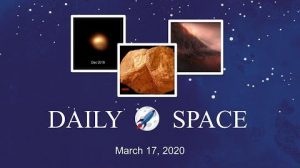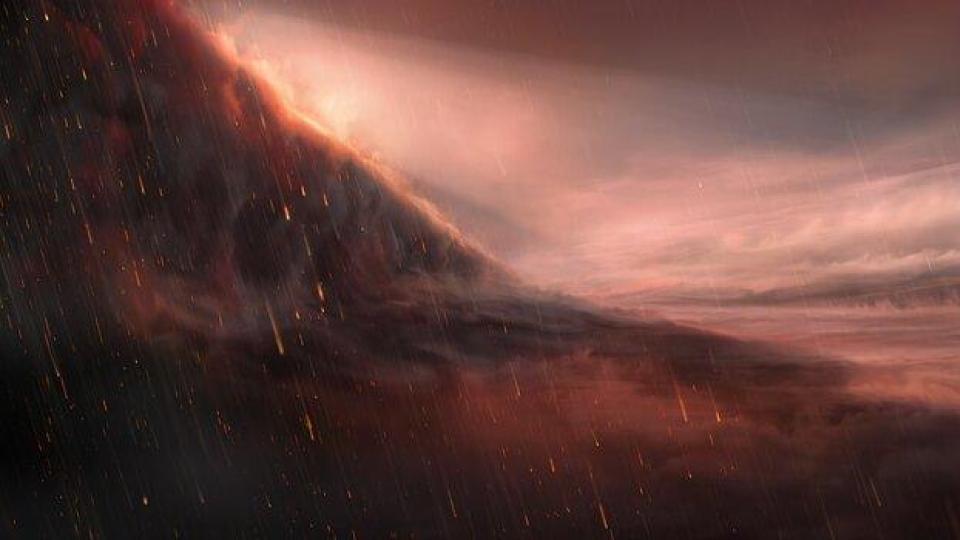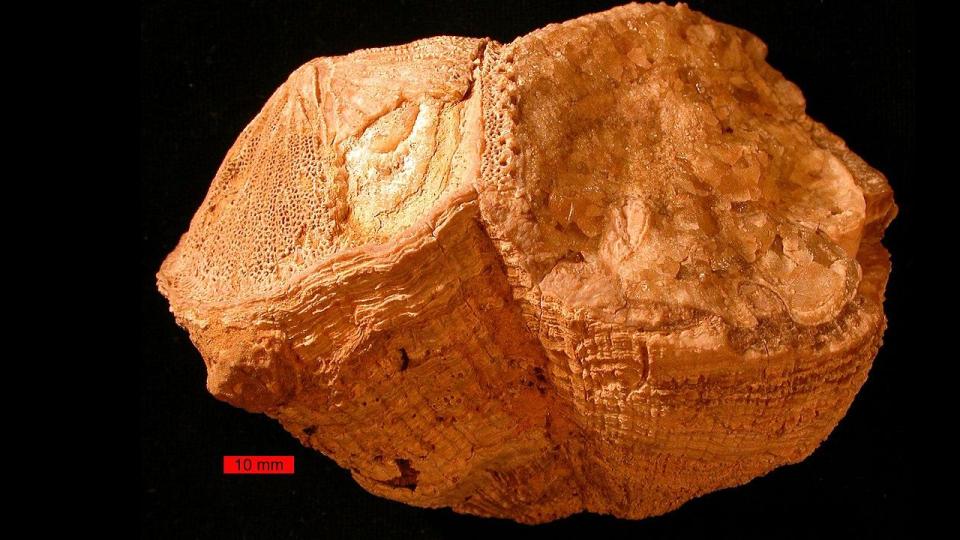
Betelgeuse is brightening back up after shedding a cloud of dust, WASP-76b turns out to be a super-hot tidally locked world that rains iron, and fossil records indicate that our days on Earth used to be much shorter.
Links
Betelgeuse shedding dust
- Dimming Betelgeuse likely isn’t cold, just dusty, new study shows (U of Washington)
Planet with iron rain
- ESO Telescope Observes Exoplanet Where It Rains Iron (ESO)
- Iron rain in the evening on a giant exoplanet (UNIGE)
Days on Earth used to be shorter
Transcript
This is the Daily Space for today, Thursday, March 17, 2020.
Welcome to the the Daily Space, I am your host, Dr Pamela Gay, and I am here to put science in your brain. Most Mondays through Fridays either I or my co-host Annie Wilson will be here, bringing you a quick run down of all that is new in space and astronomy.

Today’s news starts with a disappointing update on Betelgeuse. We are saddened to report that our favorite Red Supergiant shows no signs of going boom. After declining radically in brightness from October through January, Betelgeuse is now re-brightening in a perfectly normal way. New research from astronomers at the University of Washington and Lowell Observatory, and published in the Astrophysical Journal Letters, finds that Betelgeuse’s fainting spell was due to the shedding of a cloud of dust.
During Betelgeuse’s decline in brightness, folks had speculated that the cause was likely either the effect of massive convective cells in the star’s atmosphere cooling and darkening at the surface, or the formation of dust. Both are perfectly normal behaviors for large stars, which lose bits of their atmospheres the way most of us not so young people lose our reading glasses. Only one measurement was needed to sort which scenario was true, but that one measurement was a doozy – scientists had to measure the temperature of Betelgeuse’s surface. If Betelgeuse was dim and warm – it was dust. Dim and cold, well, that’s convection. It turns out, Betelgeuse is one warm star. The physics of this is kind of cool. The star periodically puffs out parts of its atmosphere, and as this material drifts away from the star it cools and coalesces into dust. If Betelgeuse wasn’t running away from some past event on a rapid track through the solar system, this dust would form a nebula around Betelgeuse. Instead, it forms a train behind the star, making it impossible for us to determine how much dust this system has lost over time.
From one warm star we now move to one really hot planet.

New observations collected with the Very Large Telescope in Chile have discovered that the planet WASP-76b likely experiences weather that is cloudy with a chance of iron rain.
This hot world is located 640 Light years away in the constellation Pisces and orbits a 6400 Kelvin star that is just a bit hotter than our Sun. What makes this system extraordinary is the location of the planet. It is so close to its star that it has become tidally locked to its star, so that the same side always faces the star. That starward side is estimated to be 2400 degrees Celsius, which is hot enough to vaporize metals like iron and form metal clouds that stream to the cooler side of the world. The temperature drops to 1400C on the night side of WASP 76b, and at this temperature the metal vapor condenses into droplets and rains. This implies puddles become sheets of metal and everything is coated in metal. This is both awesome and horrifying, and we feel safe saying no larger forms of life exist on this world, although no one can rule out bacteria, because bacteria like to adapt to the challenges geology gives them.

The kind of tidal effects that we see on WASP-76b affect orbits in fascinating ways. Here on Earth, we have a moon that is tidally locked so that we only see one side of the moon. This is because the more massive Earth was able to exert torques on the moon that brought it’s rotation into sync with its orbital period. The moon is trying to do the same to earth, but it’s smaller, so the process may take longer than our Earth will actually be pleasantly orbiting a normal Sun. Still, we can see hints that in the past the Earth’s days were far shorter, and now we have a pretty new example of just how short those days were. 70 Million years ago, at the end of the time of the dinosaurs, a bivalved mollusk captured the length of the day in the ridges in its shell. Using a laser beam to measure ridges too small for researchers to count with a microscope, this science team found that days appeared to be just 23.5 hours long and a year was 372 days long.
These day tracking ridges are giving scientists insights on how the tides, symbiotic relationships with photosynthesising critters, and other factors affected mollusk growth. It’s really cool to see research that hits so many different topics and we encourage you to go explore the links we have on DailySpace.org which discuss the bioscience of this story.
<———————>
And that rounds out our show for today. Tomorrow is Rocket Wednesday, and Pamela will be back with even more science on Thursday. As part of helping keep us all occupied in these really weird times, we’re going to be hosting a lot of additional content on our Twitch channel https://www.twitch.tv/cosmoquestx , and we want to remind you that CosmoQuest has an active community on Discord where you can talk science and even find other people to join you in playing some online games. You can find links to everything that is going on at CosmoQuest.org.
Thank you all for listening. Today’s script was written by Pamela Gay and the Daily Space is produced by me, Susie Murph. The Daily Space a product of the Planetary Science Institute, a 501(c)3 non profit dedicated to exploring our Solar System and beyond. We are here thanks to the generous contributions of people like you. The best way you can support us is through Patreon.com/cosmoquestx Like us? Please share us! You never know whose life you can change by adding a daily dose of science.


 We record most shows live, on Twitch. Follow us today to get alerts when we go live.
We record most shows live, on Twitch. Follow us today to get alerts when we go live.